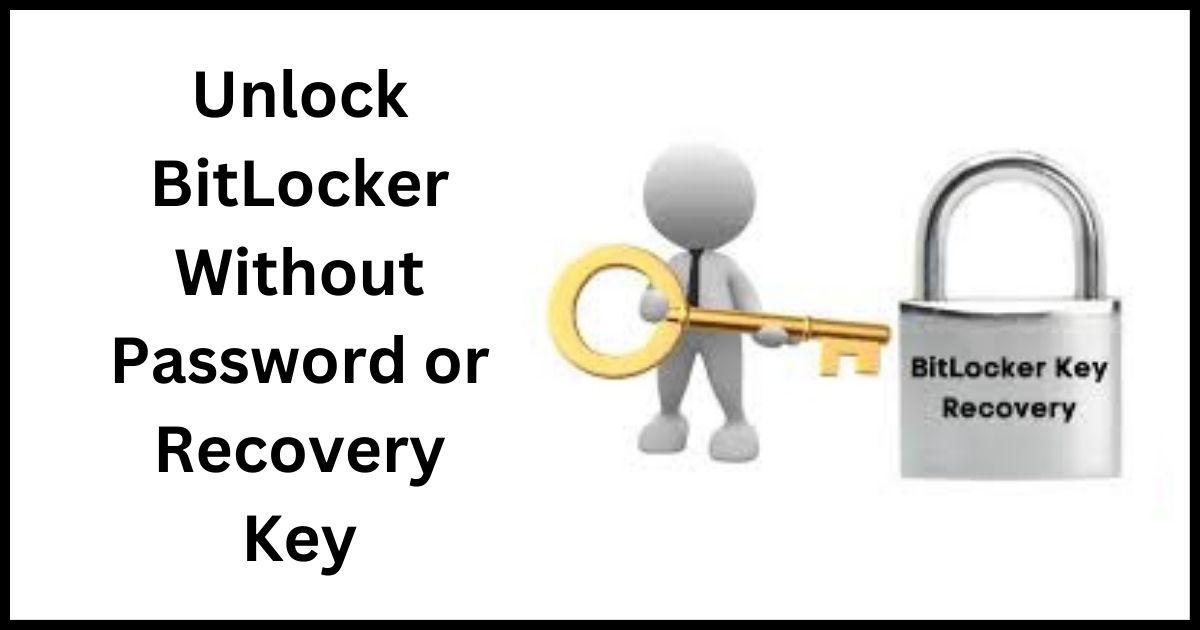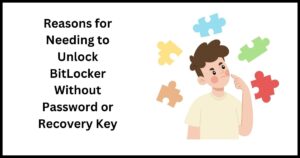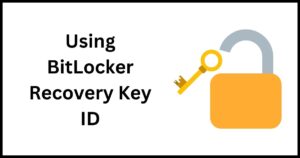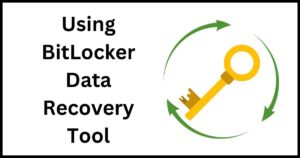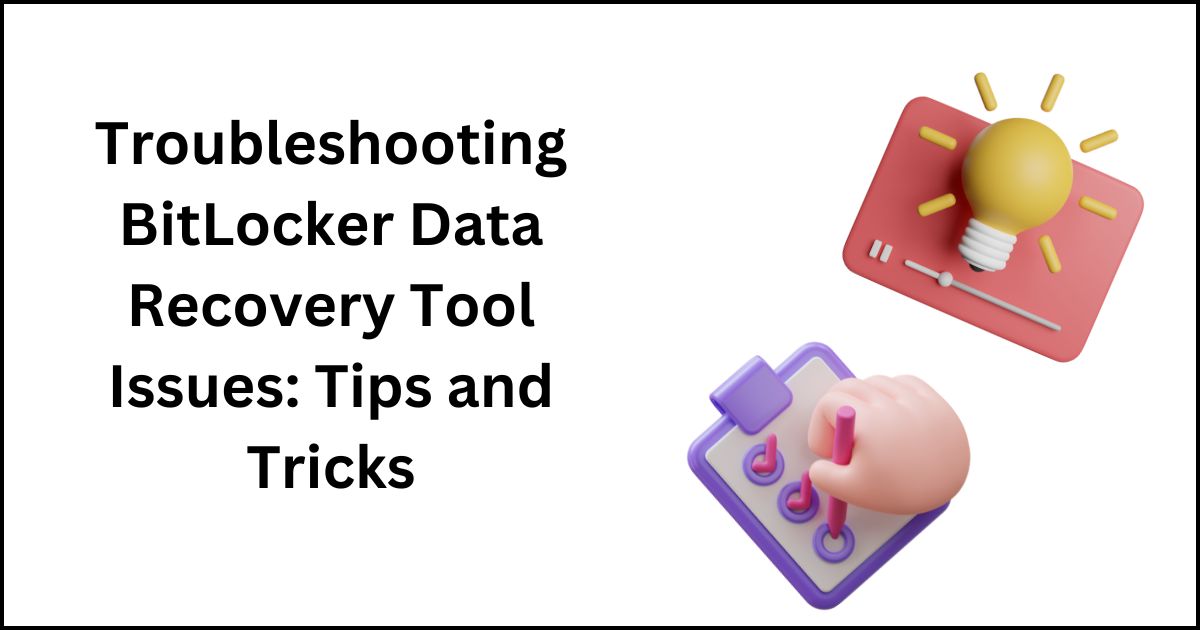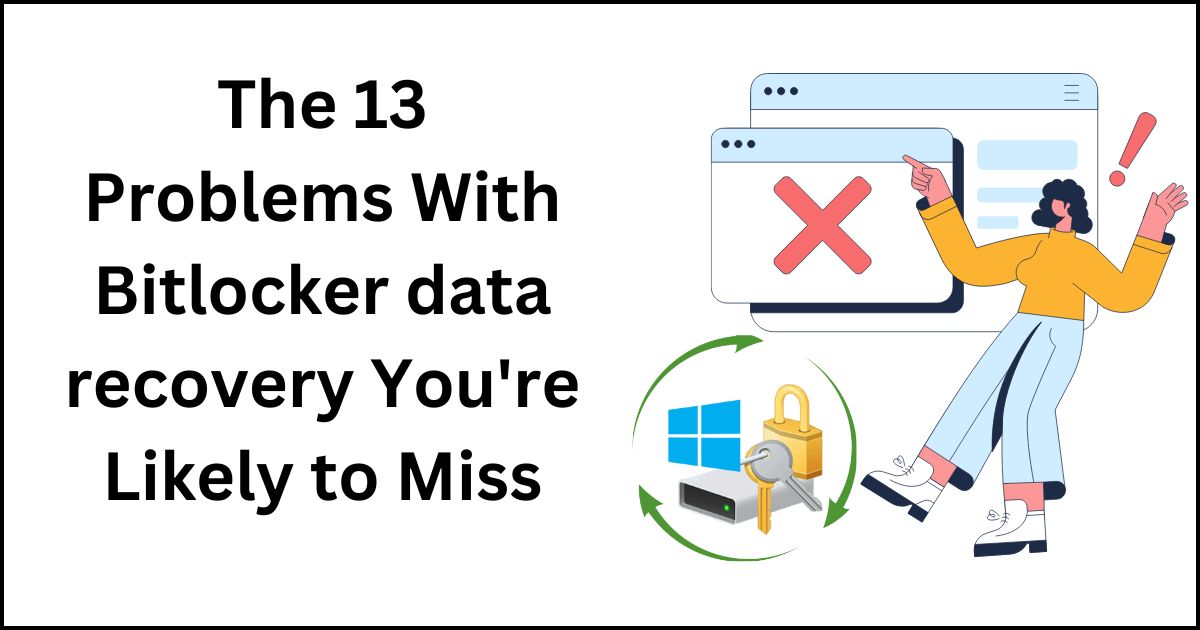Picture this scenario: You’ve forgotten your BitLocker password or, even worse, out of place your Recovery Key in your force. What’s your subsequent flow? Fear not. In this guide, you may find out a way to unencumber BitLocker while not having your password or recovery key, equipping you with the expertise to navigate via this tough scenario.
BitLocker is a Windows feature that offers sturdy encryption to protect records saved on difficult drives or detachable media. Nonetheless, misplacing the recuperation key or ignoring the password can gift an impressive obstacle. Without a bitlocker recovery key or password, there are a number of strategies and techniques that will be mentioned in this blog publish in order to unlock BitLocker.
Brief overview of BitLocker and its purpose
Here’s a brief overview of BitLocker and its key features:
- Data Encryption: Advanced encryption algorithms are utilized by BitLocker to encrypt the entire disk volume, including user data, system files, and the operating system. By implementing this encryption, the data remains safeguarded and unintelligible, notwithstanding unauthorized access to the physical drive.
- Protection Against Data Theft: By encrypting the disk volume, BitLocker helps protect against data theft in case the device is lost, stolen, or accessed by unauthorized individuals. In the absence of valid authentication credentials, such as a password or encryption key, access to the encrypted data is denied.
- Integration with Windows: BitLocker seamlessly seamlesly integration with the Windows operating system, thereby furnishing users with a streamlined interface that facilitates the administration of encryption configurations, passwords, and recovery keys. It is compatible with Windows Vista, Windows 7, Windows 8, and Windows 10 editions, among others.
- Flexible Deployment Options: BitLocker offers flexible flexible deployment options, enabling administrators to establish encryption configurations via PowerShell scripts or Group Policy. It accommodates a variety of security needs by supporting multiple encryption modes, including TPM-only, TPM with PIN, TPM with launch key, and password-only.
- Recovery Options: BitLocker includes built-in data recovery options to ensure data accessibility in case of forgotten passwords or other authentication issues. Users can create and store recovery keys, which can be used to unlock the encrypted drive if necessary.
Reasons for Needing to Unlock BitLocker Without Password or Recovery Key
There are several scenarios where users may find themselves needing to unlock BitLocker without a password or recovery key:
1.Forgotten Password: One of the most common reasons is when the user forgets the BitLocker password. Without the password, accessing the encrypted drive becomes impossible, and users may need alternative methods to unlock it.
2. Lost or Misplaced Recovery Key: Users are often provided with a BitLocker recovery key when encrypting their drives. However, if the recovery key is lost, misplaced, or not properly documented, it can be challenging to unlock the drive in case of an emergency.
3. Inherited Computer: Users who inherit a computer or receive a second-hand device with BitLocker encryption enabled may not have been provided with the password or recovery key. Without this information, they may face difficulty accessing the encrypted drive.
4. System Corruption or Failure: In some cases, system corruption or hardware failure may prevent the computer from booting properly or accessing the BitLocker-encrypted drive. This can result in being locked out of the drive even if the correct password or recovery key is entered.
5. Administrative Issues: Users may encounter administrative issues, such as being unable to contact the administrator or IT support team to retrieve the recovery key or reset the password. This can occur in organizational settings where BitLocker encryption is centrally managed.
6. Emergency Situations: In emergency situations, such as a data breach or loss of access to critical information, users may need to quickly regain access to BitLocker-encrypted drives without relying on conventional authentication methods.
Methods to Unlock BitLocker Without Password or Recovery Key
Unlocking BitLocker with out a password or recovery key may be challenging, however several techniques and techniques can assist users regain get right of entry to to their encrypted drives. Here are some methods to release BitLocker without a password or restoration key:
- Using BitLocker Recovery Key ID:
- If you have access to your BitLocker recovery key ID (usually displayed when BitLocker is enabled), you can retrieve your recovery key from your Microsoft account. Visit the BitLocker Recovery Keys page on your Microsoft account and enter the recovery key ID to get the recovery key.
- Contacting Administrator or IT Support:
- If the BitLocker-encrypted drive is managed by an organization or IT department, contact the administrator or IT support team. They may have procedures in place to help users recover access to BitLocker-encrypted drives, such as providing a recovery key or resetting the password.
- Disabling BitLocker (Last Resort):
- Disabling BitLocker is a last resort option, as it will result in the loss of all data on the drive. However, if none of the above methods work, you may need to consider disabling BitLocker through the BitLocker management interface in Windows. This action will decrypt the drive, allowing you to access the data.
- Using BitLocker Repair Tool:
- Windows provides a tool called the BitLocker Repair Tool, which can help recover data from a damaged or corrupted BitLocker-encrypted drive. This tool may also assist in unlocking the drive if you’re unable to do so using other methods. However, its effectiveness may vary depending on the severity of the issue.
- Using Third-Party Tools:
- There are third-party tools and software available that claim to unlock BitLocker-encrypted drives without a password or recovery key. These tools often use advanced techniques to bypass BitLocker encryption or recover the encryption key. However, caution should be exercised when using third-party tools, as they may not always be reliable or secure.
It’s important to note that some methods may require administrative privileges or access to specific accounts or recovery resources.
Methods to Unlock BitLocker Without Password or Recovery Key
1.Using BitLocker Recovery Key ID:
Using the BitLocker Recovery Key ID is a straightforward method to retrieve the recovery key from your Microsoft account.
When BitLocker is enabled on a drive, a unique bitlocker key generator and displayed to the user. To access the recovery key, users can visit the BitLocker Recovery Keys page on their Microsoft account and enter the recovery key ID. Once the recovery key ID is provided, Microsoft retrieves the associated recovery key from its servers and displays it to the user.
This method offers a convenient way to regain access to a BitLocker-encrypted drive without the need for the original password or recovery key. However, it requires users to have access to their Microsoft account and remember the recovery key ID associated with the encrypted drive. Additionally, users should ensure the security of their Microsoft account credentials to prevent unauthorized access to their recovery keys. Overall, using the BitLocker Recovery Key ID can be an effective solution for recovering access to BitLocker-encrypted drives in situations where the password or recovery key is unavailable.
2. Contacting Administrator or IT Support
When faced with the need to unlock a BitLocker-encrypted drive without a password or recovery key, contacting the administrator or IT support is often the most prudent course of action. Organizations that utilize BitLocker encryption typically have established procedures and protocols in place to assist users in such situations. IT support teams are equipped to handle BitLocker-related issues and may have access to recovery keys or the ability to reset passwords.
By reaching out to the administrator or IT support, users can expedite the process of regaining access to their encrypted drives. IT professionals can verify the user’s identity, retrieve the necessary recovery keys or reset passwords as needed, and provide guidance on unlocking BitLocker-encrypted drives securely.
Additionally, administrators may have access to centralized management tools or platforms that facilitate recovery operations across multiple devices or users. This centralized approach streamlines the recovery process and ensures consistency in handling BitLocker-related incidents within the organization.
Overall, contacting the administrator or IT support is a proactive step towards resolving BitLocker-related issues efficiently and ensuring the security of encrypted data.
3. Disabling BitLocker (Last Resort):
Consider disabling BitLocker as a last resort option when you have exhausted all other methods of unlocking the encrypted drive. It involves decrypting the drive, which results in the loss of all data stored on the drive. This action should only be taken if the data on the encrypted drive is not critical or if it has been backed up elsewhere.
To disable BitLocker, users can access the BitLocker management interface in Windows and select the option to turn off BitLocker encryption for the drive in question. This process may require administrative privileges and may take some time depending on the size of the drive and the amount of data stored on it.
It’s important to note that disabling BitLocker should be approached with caution, as it permanently removes the encryption protection from the drive. Users should ensure that they have backed up any important data stored on the encrypted drive before proceeding with this action. Additionally, users should consider re-enabling BitLocker or implementing alternative security measures to protect their data after disabling BitLocker.
4. Using BitLocker Data Recovery Tool
there may be instances where users encounter issues accessing BitLocker-encrypted drives due to various reasons such as forgotten passwords, lost recovery keys, or drive corruption. In such cases, BitLocker Data Recovery Tool comes to the rescue, providing users with a means to recover their encrypted data effectively.
- Understanding BitLocker Data Recovery Tool:
- BitLocker Data Recovery Tool is a utility provided by Microsoft as part of the Windows operating system. The tool helps users recover data from BitLocker-encrypted drives in cases. Where they are unable to access the drive due to authentication issues or drive corruption.
- The tool employs advanced algorithms and techniques to scan and analyze the encrypted drive. Consequently, Attempting to bitlocker file recover the encryption key or repair any corruption that may be causing access issues.
- Scenarios Where BitLocker Data Recovery Tool Can Help:
- Forgotten Password: If a user forgets the BitLocker password required to unlock the encrypted drive. The BitLocker Data Recovery Tool can assist in recovering or resetting the password.
- Lost Recovery Key: In the event of a lost or misplaced BitLocker recovery key, the data recovery software can help retrieve or regenerate the recovery key, allowing users to regain access to the encrypted drive.
- Drive Corruption: If the BitLocker-encrypted drive becomes corrupted or inaccessible due to hardware failure. System errors, or other factors, the tool can attempt to repair the drive and recover the encrypted data.
- Using BitLocker Data Recovery Tool:
- Accessing the Tool: The Windows operating system integrates the BitLocker data recovery tool, which users can access through various methods . Including Control Panel, Windows Recovery Environment (WinRE), or PowerShell command..
- Recovery Process: The tool typically guides users through a step-by-step recovery process. Afterward, Prompting them to provide necessary information such as drive details, recovery options, and authentication credentials.
- Recovery Key Backup: Users may need to submit a BitLocker recovery key backup file or use other authentication methods to confirm their identity and start the recovery process.
- Repair and Recovery: Depending on the specific issue encountered. The tool may attempt to repair the drive, recover the encryption key, or regenerate the recovery key to unlock the BitLocker-encrypted drive successfully.
- Considerations and Best Practices:
- Backup Recovery Key: It’s essential to maintain backup copies of the BitLocker recovery key in a secure location . To facilitate data recovery in case of emergencies.
- Regular Updates: Keep the BitLocker Data Recovery Tool and associated software up-to-date . Ensure compatibility with the latest security patches and enhancements.
- Professional Assistance: In complex or severe data loss scenarios. Afterward, Consider seeking professional assistance from data recovery experts or IT support professionals familiar with BitLocker encryption and recovery procedures.
In conclusion, BitLocker Data Recovery Tool serves as a valuable resource for recovering data from BitLocker-encrypted drives in situations . Where access is denied due to password issues, lost recovery keys, or drive corruption. By understanding how to use the tool effectively and following best practices for data protection. Users can mitigate the impact of data loss and maintain the security of their encrypted data.
Tips for Preventing Future Lockouts
Preventing future lockouts from BitLocker-encrypted drives is crucial to maintaining data accessibility and security. Here are some tips to help prevent future lockouts:
- Backup Recovery Keys: Regularly back up BitLocker recovery keys and store them securely. Keep multiple copies of the recovery keys in different locations to ensure redundancy and accessibility in case of emergencies.
- Store Recovery Keys Safely: Store recovery keys in a secure location. Such as a password manager, encrypted storage device, or physical safe. Avoid storing recovery keys on the same device as the encrypted drive to prevent loss in case of device failure.
- Enable Multi-Factor Authentication: Implement multi-factor authentication for accessing BitLocker-encrypted drives. Require users to provide additional authentication factors. Such as a PIN or biometric scan, in addition to the password, to enhance security.
- Regularly Update Recovery Information: Update recovery information, such as contact details and recovery key storage locations, as needed. Ensure that recovery information is current and accessible to authorized individuals who may need to assist in unlocking encrypted drives.
- Educate Users: Provide users with training and education on BitLocker encryption best practices. Teach them how to securely store recovery keys, recognize phishing attempts, and follow proper procedures for accessing encrypted drives.
- Monitor System Health: Regularly monitor the health and status of BitLocker-encrypted drives to detect any issues or anomalies early. Afterward, Implement monitoring tools or solutions that provide alerts for drive health, encryption status, and security events.
- Implement Group Policies: Configure Group Policies to enforce BitLocker encryption settings and security policies across the organization. Define policies for password complexity, encryption strength, and recovery key management to ensure consistency and compliance.
- Regularly Review Security Policies: Periodically review and update security policies related to BitLocker encryption. Consider changes in technology, industry regulations, and security best practices to ensure that security policies remain effective and up-to-date.
- Perform Regular Audits: Conduct regular audits of BitLocker encryption implementation and compliance. Ensure to configure encryption settings correctly, to store recovery keys securely, and to enforce access controls properly.
- Plan for Contingencies: Develop contingency plans and procedures for handling BitLocker-related incidents, such as lost recovery keys or forgotten passwords. Subsequently, Establish clear protocols for recovering access to encrypted drives and mitigating the impact of lockouts.
- Test Recovery Procedures: Test recovery procedures and protocols periodically to ensure their effectiveness. Meanwhile, Conducting simulated recovery scenarios validates the ability to retrieve and successfully use recovery keys in real-world situations.
- Keep Software Up-to-Date: Ensure that BitLocker encryption software and related components are kept up-to-date . With the latest security patches and updates. Regularly apply software updates to address security vulnerabilities and enhance system reliability.
Conclusion:
In conclusion, while being locked out of a BitLocker-encrypted drive without a password or bitlocker recovery key tool . It can be a daunting situation. There are several methods and techniques available to regain access. By understanding the various options and implementing best practices for data security. Users can mitigate the risk of lockouts and ensure the safety of their encrypted data.
Remember, prevention is key, so always store recovery keys and passwords securely. Consider implementing additional security measures to safeguard against potential lockouts in the future.
